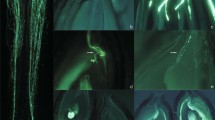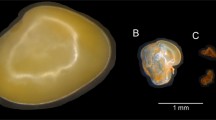Summary
Flowers of cultivated buckwheat (Fagopyrum esculentum Moench) often receive natural pollen loads of fewer than 10 pollen grains. The cultivated varieties also have high genetic variability. These observations raise the question of whether seed production in buckwheat is often limited by pollen delivery, and whether small increases in pollen load could result in gametophytic selection through pollen grain competition. In greenhouse-grown buckwheat plants, embryo sac penetration by pollen tubes was universal with 10 or more pollen grains. However, seed production increased with pollen load up to 30 grains per flower. Larger pollen loads, which intensify selection among gametophytes, resulted in more vigorous progeny. Seedlings produced from high pollen load (15–20 pollen grains) were larger (40% by weight) than those from low pollen load (5 pollen grains). These results are evidence that pollen grain competition can occur in buckwheat with benefits for progeny performance.
Similar content being viewed by others
References
Adachi, T., 1990. How to combine the reproductive system with biotechnology in order to overcome the barrier to breeding in buckwheat. Fagopyrum 10: 7–11.
Adachi, T., K. Kawabata, N. Matsuzaki, T. Yabuya & T. Nagatomo, 1983. Observation of pollen tube elongation, fertilization and ovule development in autogamous autotetraploid buckwheat. In: T. Adachi (Ed.) 2nd International Symposium on Buckwheat, Miyazaki, Japan, pp. 103–113.
Bertin, R.I., 1990. Effects of pollination intensity inCampsis radicans. Amer. J. Bot. 77: 178–187.
Björkman, T., 1994. The effectiveness of heterostyly in preventing illegitimate pollination in dish-shaped flowers. Sex. Plant Reprod. (in press).
Björkman, T., 1995. The role of honeybees in the pollination of buckwheat (Fagopyrum esculentum). J Econ. Entomol. (in press).
Campbell, C.G., 1983. Manor buckwheat. Can. J. Plant Sci. 63: 1053–1054.
Charlesworth, D. & B. Charlesworth, 1992. The effects of selection in the gametophyte stage on mutational load. Evolution 46: 703–720.
Cruzan, M.B., 1986. Pollen tube distributions inNicotiana glauca: evidence for density-dependent growth. Amer. J. Bot. 73: 902–907.
Esser, K., 1953. Genomverdopplung und Pollenschlauchwachstum bei Heterostylen. Z. Indukt. Abstam. Vererb. 85: 28–50.
Herrera, C.M., 1990. Brood size reduction inLavandula latifolia Labiatae a test of alternative hypotheses. Evol. Trends Plants 4: 99–106.
Horobowicz, M. & R. Obendorf, 1992. Changes in sterols and fatty acids of buckwheat endosperm and embryo during seed development. J. Agric. Food Chem. 40: 745–750.
Marshall, H.G., 1979. Studies of inbreeding depression, breeding behavior, and heterosis with inbred line of buckwheat. Crop Sci. 112: 110–114.
McKenna, M.A., 1986. Heterostyly and microgametophytic selection: The effect of pollen competition of sporophytic vigor in two distylcus species. In: D.L. Mulcahy, G.B. Mulcahy & E. Ottaviano (Eds) Biotechnology and ecology of pollen. Springer, Berlin, pp. 443–448.
Morris, M.R., 1951. Cytogenetic studies on buckwheat. Genetic and cytological studies of compatibility in relation to heterostyly in common buckwheat,Fagopyrum sagittatum. J. Heredity 42: 85–89.
Morton, B.R., 1966. A study of pollination and pollen tube growth in buckwheatFagopyrum sagittatum Gilib. Pennsylvania State University. MS Thesis, 58 pp.
Mulcahy, D.L., 1971. A correlation between gametophytic and sporophytic characteristics ofZea mays L. Science 171: 1155–1156.
Mulcahy, D.L., P.S. Curtis & A.A. Snow, 1983. Pollen competition in a natural population. In: C.E. Jones & R.J. Little (Eds.) Handbook of pollination biology. Van Nostrand Reinhold. New York, pp. 330–337.
Mulcahy, D.L. & G.B. Mulcahy, 1975. The influence of gametophytic competition on sporophyte quality inDianthus chinensis. Theor. Appl. Genet. 46: 277–280.
Namai, H., 1990. Pollination biology and reproductive ecology for improving genetics and breeding common buckwheat,Fagopyrum esculentum (1). Fagopyrum 10: 23–46.
Namai, H. & R. Ohsawa, 1986. Variation of reproductive success rates of ovule and pollen deposited upon stigmas according to the different number of pollen on a stigma in angiosperm. In: D.L. Mulcahy, G.B. Mulcahy & E. Ottaviano (Eds.) Biotechnology and ecology of pollen. Springer, Berlin, pp. 423–428.
O'Donnell, M.E. & K.S. Bawa, 1993. Gamete selection and patterns of ovule and seed abortion. Current Science 65: 214–219.
Ohnishi, O., 1985. Population genetics of cultivated common buckwheat,Fagopyrumesculentum III. Frequency of sterility mutants in Japanese populations. Jpn. J. Genet. 60: 391–404.
Ohnishi, O., 1988. Population genetics of cultivated common buckwheat,Fagopyrum esculentum VI. The amount of detrimental mutant genes concealed in a population is the same in all local races in the world. Jpn. J. Genet. 63: 67–73.
Schoch-Bodmer, H., 1930. Zur heterostylie vonFagopyrum esculentum. Untersuchungen über das Pollenschlauchwachstum und über die Saugkrafte der Griffel und Pollenkörner. Ber. Schweiz. Bot. Ges. 39: 4–15.
Schoch-Bodmer, H., 1934. Heterostylieproblem: Griffelbeschaffenheit und Pollenschlauchwachstum beiFagopyrum esculentum. Planta 22: 149–152.
Shore, J. & S.C.H. Barrett, 1984. The effect of pollination intensity and incompatible pollen on seed set inTurnera ulmifolia. Can. J. Bot. 62: 1298–1303.
Snow, A., 1986. Evidence for and against pollen tube competition in natural populations. In: D.L. Mulcahy, G.B. Mulcahy & E. Ottaviano (Eds.) Biotechnology and ecology of pollen. Springer, Berlin, pp. 405–410.
Spira, T.P., A.A. Snow, D.F. Whigham & J. Leak, 1992. Flower visitation, pollen deposition, and pollen-tube competition inHibiscus moscheutos (Malvaceae). Amer. J. Bot. 79: 428–433.
Stephenson, A.B. & R.I. Bertin, 1983. Male competition, female choice and sexual selection in plants. In: L. Real (Ed.) Pollination Biology. Academic Press, New York, pp. 109–149.
Sutherland, S., 1987. Why hermaphroditic plants produce many more flowers than fruits, experimental tests withAgave mekelveyana. Evolution 41: 750–759.
Ter-Avanesian, D.V., 1949. The influence of the number of pollen grains used in pollination. Bull. Appl. Genet. Plant Breed. 28: 119–133.
Ter-Avanesian, D.V., 1978. The effect of varying the number of pollen grains used in fertilization. Theor. Appl. Genet. 52: 77–79.
Wiens, D., C.L. Calvin, C.A. Wilson, C.I. Davern, D. Frank & S.R. Seavey, 1987. Reproductive success, spontaneous embryo abortion, and genetic load in flowering plants. Oecologia 71: 501–509.
Willson, M.F., N. Burley, 1983. Mate choice in plants. Tactics, mechanisms and consequences, Princeton Univ. Press. Princeton.
Winsor, J., L. Davis & A. Stephenson, 1987. The relationship between pollen load and fruit maturation and the effect of pollen load on offspring vigor inCucurbita pepo. Amer. Nat. 129: 643–656.
Author information
Authors and Affiliations
Rights and permissions
About this article
Cite this article
Björkman, T. The effect of pollen load and pollen grain competition on fertilization success and progeny performance inFagopyrum esculentum . Euphytica 83, 47–52 (1995). https://doi.org/10.1007/BF01677860
Received:
Accepted:
Issue Date:
DOI: https://doi.org/10.1007/BF01677860




